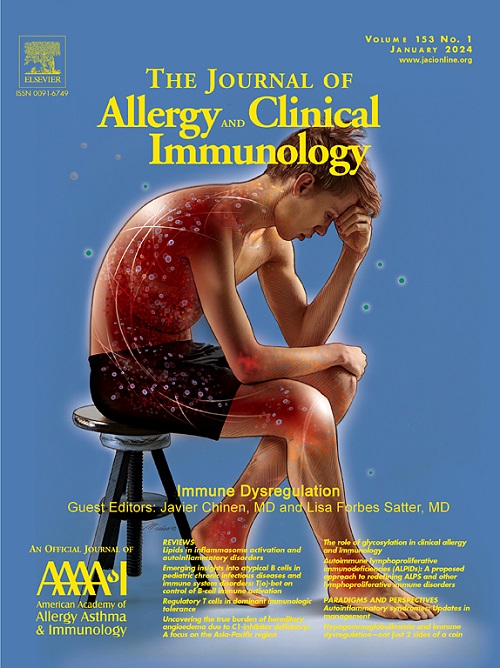Antibody-secreting cell repertoires hold high-affinity anti-rocuronium specificities that can induce anaphylaxis in vivo
IF 11.4
1区 医学
Q1 ALLERGY
引用次数: 0
Abstract
Background
Neuromuscular blocking agents (NMBAs) are muscle relaxants used to assist mechanical ventilation but lead in 1 per 10,000 anesthesia cases to severe acute hypersensitivity reactions—that is, anaphylaxis. Incidences vary between types of NMBAs. Rocuronium, a widely used nondepolarizing aminosteroid NMBA, induces among the highest anaphylaxis rates. Rocuronium-induced anaphylaxis is proposed to rely on preexisting rocuronium-binding antibodies, but no such antibodies have ever been identified.
Objectives
We sought to identify rocuronium-specific antibody repertoires from plasma cells or plasmablasts of rocuronium-immunized mice to determine the affinities, structures, and anaphylactogenic potential of these antibodies for rocuronium.
Methods
We engrafted rocuronium onto carrier proteins allowing immunization of mice against rocuronium, screening for rocuronium-specific antibody responses, and sorting of rocuronium-specific plasma cells using droplet microfluids coupled to single-cell antibody gene (variable heavy chain [VH] and variable light chain [VL]) sequencing.
Results
The 2 different repertoires of >500 VH-VL pairs were oligoclonal, comprised 3 major clonal families, and displayed convergence. Expressed as human IgG1, these antibodies demonstrated subnanomolar affinities for rocuronium with families either monospecific for rocuronium or cross-reactive only for closely related NMBAs. Expressed as human IgE, they triggered human mast cell and basophil activation, and severe passive systemic anaphylaxis in mice humanized for the IgE receptor FcεRI. Cocrystal structures between rocuronium and antibody representatives of 3 different VH-VL families revealed distinct interaction modes, with the ammonium group involved systematically in the binding interface.
Conclusions
This work identifies the epitopes of antibody reactivity to rocuronium, demonstrates anaphylactogenic potential of anti-rocuronium IgE, and establishes the first mouse model of NMBA anaphylaxis.

抗体分泌细胞具有高亲和力的抗罗库溴铵特异性,可在体内诱导过敏反应。
背景:神经肌肉阻滞剂(NMBA)是一种用于辅助机械通气的肌肉松弛剂,但导致严重急性超敏反应(即过敏反应)的麻醉发生率为万分之一。不同类型的nmba发病率不同。罗库溴铵是一种广泛使用的非去极化氨基类固醇NMBA,引起最高的过敏反应率。罗库溴铵引起的过敏反应被认为依赖于预先存在的罗库溴铵结合抗体,但没有发现这样的抗体。目的:从罗库溴铵免疫小鼠的浆细胞或质母细胞中鉴定罗库溴铵特异性抗体库,并确定这些抗体对罗库溴铵的亲和力、结构和致敏潜力。方法:将罗库溴铵移植到载体蛋白上,利用微滴微流体偶联单细胞抗体基因(VH和VL)测序技术,对小鼠进行罗库溴铵免疫,筛选罗库溴铵特异性抗体反应,对罗库溴铵特异性浆细胞进行分选。结果:bbb500vh - vl对的两种不同谱均为寡克隆,由3大克隆科组成,且具有收敛性。这些抗体以人IgG1形式表达,对罗库溴铵表现出亚纳摩尔亲和力,其家族要么对罗库溴铵单特异性,要么仅对密切相关的nmba具有交叉反应性。它们以人IgE的形式表达,引发人肥大细胞和嗜碱性粒细胞的激活,并在IgE受体FcεRI人源化的小鼠中引发严重的被动全身过敏反应。罗库溴铵与三个不同VH-VL家族的抗体代表物之间的共晶结构显示出不同的相互作用模式,但铵基系统地参与结合界面。结论:本工作鉴定了抗体对罗库溴铵的反应性表位,证实了抗罗库溴铵IgE的致敏潜力,建立了首个小鼠NMBA过敏反应模型。
本文章由计算机程序翻译,如有差异,请以英文原文为准。
求助全文
约1分钟内获得全文
求助全文
来源期刊
CiteScore
25.90
自引率
7.70%
发文量
1302
审稿时长
38 days
期刊介绍:
The Journal of Allergy and Clinical Immunology is a prestigious publication that features groundbreaking research in the fields of Allergy, Asthma, and Immunology. This influential journal publishes high-impact research papers that explore various topics, including asthma, food allergy, allergic rhinitis, atopic dermatitis, primary immune deficiencies, occupational and environmental allergy, and other allergic and immunologic diseases. The articles not only report on clinical trials and mechanistic studies but also provide insights into novel therapies, underlying mechanisms, and important discoveries that contribute to our understanding of these diseases. By sharing this valuable information, the journal aims to enhance the diagnosis and management of patients in the future.

 求助内容:
求助内容: 应助结果提醒方式:
应助结果提醒方式:


